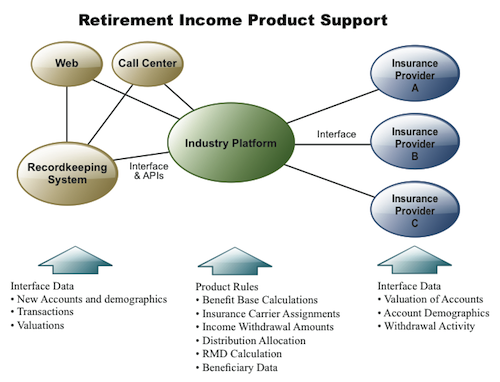Although most 401(k) plan sponsors remain ambivalent about offering in-plan retirement income solutions, in-plan solutions represent an important growth industry for certain retirement plan service providers.
So the topic of in-plan solutions received a fair share of attention at the SPARK National Conference in Washington, DC, earlier this week (though not as much attention as the well-intentioned but nonetheless disruptive new regulations that are emerging at a snail-mail pace from the Department of Labor).
Three companies that offer an in-plan income option—Hartford, Prudential and BlackRock (with MetLife)—sent delegates to speak the conference. And Chicago-based Mesirow Financial, an advisor to ERISA product manufacturers, weighed in with a preliminary evaluation of such programs.
A product review by an advisor like Mesirow allows manufacturers to represent their products as ERISA-worthy. Chris O’Neill, Mesirow’s chief investment officer and research director for investment strategies, has analyzed from both fixed and variable in-plan options and found them, at least in principle, to add value as options in employer-sponsored retirement plans.
“We are [in-plan] product advocates,” O’Neill said at the SPARK conference. “We would like to see these products better understood and utilized more.”
O’Neill sat on a panel with Patricia Harris of Hartford, which offers the Hartford Income for Life fixed deferred income annuity program and Susan Unvarsky of Prudential Retirement, which offers the IncomeFlex in-plan guaranteed lifetime withdrawal benefit.
O’Neill said there was still some fiduciary concern that participants might end up paying for benefits they don’t receive—either because the insurer fails during a financial pandemic or because of a portability snafu or because participants particularly in situations where they withdraw too much from their accounts without understanding that they’re reducing their level of guaranteed income.
But “Does the product add value and improve retirement portfolios? Mesirow says yes on both counts,” O’Neill said.
Hartford Lifetime Income and Prudential IncomeFlex represent two very different types of in-plan income option. With the Hartford product, a fixed deferred income annuity, participants can buy increments of future monthly income from the Hartford, typically starting at age 65. If they choose, they can reverse the purchases. IncomeFlex is a lifetime income benefit rider attached to target date funds and provides income without annuitization.
In a separate presentation, BlackRock’s Chip Castille talked about his firm’s LifePath Portfolios in-plan income product. Once known as SponsorMatch, the product was introduced by Barclays Global Investors in 2007, with MetLife as the insurance partner. In 2009, BlackRock bought BGI from Barclays, the British bank. Since then, the company has been working to make the product more palatable to plan sponsors—it has not announced any sales yet.
LifePath is a series of target date funds-of-funds that include, as one of the underlying investments, a group “unallocated” deferred income annuity. Over time, an increasing amount of the participant’s contributions to his or her LifePath TDF goes into the annuity option, peaking at 50% at the anticipated point of retirement.
In contrast to the Hartford product, LifePath doesn’t require participants to enter into a contract with the annuity issuer until retirement—and they can choose cash instead even then.
As Castille put it, the participant can use LifePath for years and sell it back “at fair value” to BlackRock when they leave the company. MetLife is so far the only insurer working with BlackRock on LifePath, but BlackRock is looking to offer LifePath clients a choice of interchangeable insurers.
Castille’s presentation was noteworthy in that he emphasized the importance of positioning in-plan income annuities as a way to for participants to achieve “a higher income replacement” in retirement than as a way to avoid running out of money.
“The defined contribution system can do more at the margins by putting these plans into place,” he said, asserting that an annuity can boost the pre-retirement income replacement rate of a retirement portfolio by about 2.5%, or almost as much as working for an additional three years.
In advocating the use of gain rather than loss as a motivator in selling annuities—greed rather than fear, as it were—he was transferring an insight from the out-of-plan annuity distribution world to the (still largely unrealized) in-plan annuity distribution world. To hear it in the retirement plan context seemed novel.
Thanks to the mortality credit, a life income annuity can provide the same amount of retirement income as a bond ladder but at about 30% less cost, Castille said. That kind of savings will be essential for the average participant, whose $150,000 401(k) account balance at retirement will only replace about 9% of his pre-retirement income, he noted.
To overcome the recordkeeping hurdles ordinarily associated with adopting an in-plan income option, BlackRock offers LifePath in conjunction with the SunGard Income Window. . Announced last fall, the Income Window is a middleware solution that serves as a kind of universal connection between any plan recordkeeper and LifePath.
“To the recordkeeper, LifePath looks like a single option,” Castille said. When a participant invests, “Income Window goes into the recordkeeper, gets the age of the participant, and then the fund manager puts the money into the right TDF.” At retirement, participants can defer income and/or customize their income stream, while “SunGard manages the delivery of the information to the participant.”
© 2011 RIJ Publishing LLC. All rights reserved.







